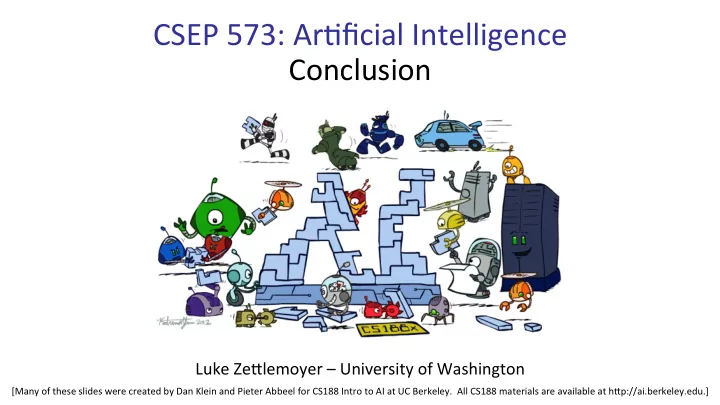

CSEP 573: Ar,ficial Intelligence Conclusion Luke Ze=lemoyer – University of Washington [Many of these slides were created by Dan Klein and Pieter Abbeel for CS188 Intro to AI at UC Berkeley. All CS188 materials are available at h=p://ai.berkeley.edu.]
CourseTopics § Hidden Markov Models § Search § Markov chains, DBNs § Problem spaces § Forward algorithm § BFS, DFS, UCS, A* (tree and graph), local search § Particle Filters § Completeness and Op,mality § Bayesian Networks § Heuris,cs: admissibility and consistency; pa=ern DBs § Basic definition, independence (d-sep) § Games § Variable elimination § Minimax, Alpha-beta pruning, § Sampling (rejection, importance) § Expec,max § Learning § Evalua,on Func,ons § Naive Bayes § MDPs § Perceptron § Bellman equa,ons Neural Networks (not on exam) § § Value itera,on, policy itera,on § Reinforcement Learning Explora,on vs Exploita,on § Model-based vs. model-free § Q-learning § Linear value func,on approx. §
What is intelligence? § (bounded) Ra,onality § Agent has a performance measure to op,mize § Given its state of knowledge § Choose op,mal ac,on § With limited computa,onal resources § Human-like intelligence/behavior
Search in Discrete State Spaces § Every discrete problem can be cast as a search problem. § states, ac,ons, transi,ons, cost, goal-test § Types § uninformed systema,c: ofen slow § DFS, BFS, uniform-cost, itera,ve deepening § Heuris,c-guided: be=er § Greedy best first, A* § relaxa,on leads to heuris,cs § Local: fast, fewer guarantees; ofen local op,mal § Hill climbing and varia,ons § Simulated Annealing: global op,mal § (Local) Beam Search
Which Algorithm? § A*, Manhattan Heuristic:
Constraint Sa,sfac,on Problems § Standard search problems: § State is a “black box”: arbitrary data structure § Goal test can be any func,on over states § Successor func,on can also be anything § Constraint sa,sfac,on problems (CSPs): § A special subset of search problems § State is defined by variables X i with values from a domain D (some,mes D depends on i ) § Goal test is a set of constraints specifying allowable combina,ons of values for subsets of variables § Making use of CSP formula,on allows for op,mized algorithms § Typical example of trading generality for u,lity (in this case, speed)
Example: Sudoku Variables: § Each (open) square § Domains: § {1,2,…,9} § Constraints: § 9-way alldiff for each column 9-way alldiff for each row 9-way alldiff for each region (or can have a bunch of pairwise inequality constraints)
Adversarial Search
Adversarial Search § AND/OR search space (max, min) § minimax objec,ve func,on § minimax algorithm (~dfs) § alpha-beta pruning § U,lity func,on for par,al search § Learning u,lity func,ons by playing with itself § Openings/Endgame databases
Big News Today!
Markov Decision Processes § An MDP is defined by: § A set of states s ∈ S § A set of ac,ons a ∈ A § A transi,on func,on T(s, a, s’) § Probability that a from s leads to s’, i.e., P(s’| s, a) § Also called the model or the dynamics § A reward func,on R(s, a, s’) § Some,mes just R(s) or R(s’) § A start state § Maybe a terminal state § MDPs are non-determinis,c search problems § One way to solve them is with expec,max search § We’ll have new tools soon [Demo – gridworld manual intro (L8D1)]
The Bellman Equa,ons § Defini,on of “op,mal u,lity” via expec,max recurrence gives a simple one-step lookahead rela,onship amongst op,mal u,lity values (1920-1984) s a s, a § These are the Bellman equa,ons, and they characterize op,mal values in a way we’ll use over and over s,a,s ’ s ’
Par,ally Observable Markov Decision Processes § An MDP is defined by: § A set of states s ∈ S § A set of ac,ons a ∈ A § A set of observa,on o ∈ O § A transi,on func,on T(s, a, s’) § Probability that a from s leads to s’, i.e., P(s’| s, a) § Also called the dynamics § A observa,on func,on O(s, a, o) § Probability of observing o, i.e., P(o| s, a) § T and O together are ofen called the model § A reward func,on R(s, a, s’) § Some,mes just R(s) or R(s’) § A start state § Maybe a terminal state
Pac-Man Beyond the Game!
Pacman: Beyond Simula,on? Students at Colorado University: h=p://pacman.elstonj.com
[VIDEO: Roomba Pacman.mp4] Pacman: Beyond Simula,on!
KR&R: Probability § Representa,on: Bayesian Networks § encode probability distribu,ons compactly § by exploi,ng condi,onal independences Earthquake Burglary Alarm § Reasoning § Exact inference: var elimina,on JohnCalls MaryCalls § Approx inference: sampling based methods § rejec,on sampling, likelihood weigh,ng, MCMC/Gibbs
KR&R: Hidden Markov Models § Representa,on § Spl form of BN § Sequence model § One hidden state, one observa,on § Reasoning/Search § most likely state sequence: Viterbi algorithm § marginal prob of one state: forward-backward
Learning Bayes Networks § We focused on Naïve Bayes and Perceptron, but you could also: § Learn Structure of Bayesian Networks § Search thru space of BN structures § Learn Parameters for a Bayesian Network § Fully observable variables § Maximum Likelihood (ML), MAP & Bayesian es,ma,on § Example: Naïve Bayes for text classifica,on § Hidden variables § Expecta,on Maximiza,on (EM)
Bayesian Learning Prior Use Bayes rule: Data Likelihood P(Y | X ) = P( X |Y) P(Y) Posterior P( X ) Normalization Or equivalently: P(Y | X ) ∝ P( X | Y) P(Y)
Personal Robo,cs
[VIDEO: 5pile_200x.mp4] PR2 (autonomous) [Mai,n-Shepard, Cusumano- Towner, Lei, Abbeel, 2010]
[VIDEO: knots_appren,ce.mp4] Autonomous tying of a knot for previously [Schulman, Ho, Lee, Abbeel, 2013] unseen situa,ons
[VIDEO: suturing-short-sped-up.mp4] Experiment: Suturing [Schulman, Gupta, Venkatesan, Tayson-Frederick, Abbeel, 2013]
Where to Go Next?
That’s It! § Help us out with some course evalua,ons § Have a great string, and always maximize your expected u,li,es!
Recommend
More recommend